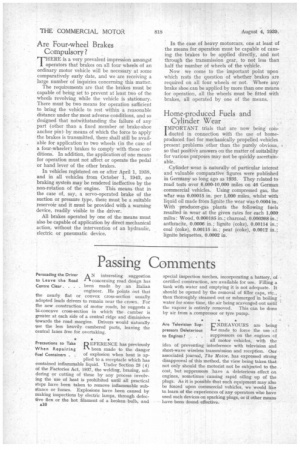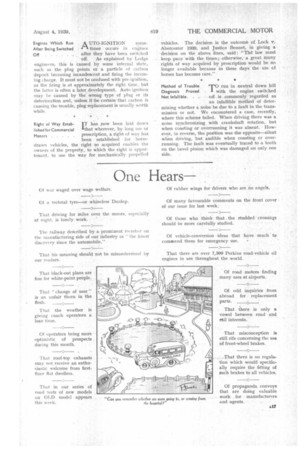Passing Comments
Page 18

Page 19

If you've noticed an error in this article please click here to report it so we can fix it.
Persuading the Driver A N interesting suggestion to Leave the Road .1-1 concerning road design has Centre Clear. . . been made by an Italian
engineer. He points out that the nearly flat or convex cross-section usually adopted leads drivers to remain near the crown. For the new construction of motor roads, he suggests a hi-concave cross-section in which the camber is greater at each side of a central ridge and diminishes towards the road margins. Drivers would naturally use the less heavily cambered parts, leaving the central lanes free for overtaking.
Precautions to Take pt EFERENCE has previously When Repairing I N. been made to the danger Fuel Containers . . of explosion when heat is applied to a receptacle which has contained inflammable liquid. Under Section 28 (4) of the Factories Act, 1937, the welding, brazing, soldering or cutting of these by any process involving the use of heat is prohibited until all practical steps have been taken to remove inflammable substance or fumes. Explosions have been caused by making inspections by electric lamps, through defective flex or the hot filament of a broken bulb, and £1.6
special inspection torches, incorporating a battery, of certified construction, are available for use. Filling a tank with water and emptying it is not adequate. It should be opened by the removal of filler caps, etc., then thoroughly steamed out or submerged in boiling water for some time, the air being scavenged out until ' the vapour is entirely removed. This can be done by air from a compressor or tyre pump.
ENDEAVOURS are being .1--A made to force the use a suppressors on the engines of all motor vehicles, with the idea of preventing interference with television and short-wave wireless transmission and reception. Our associated journal, The Motor, has expressed strong disapproval of this method, the view being taken that not only should the motorist not be subjected to the cost, but suppressors have a deleterious effect on engines, sometimes causing rapid oiling up of the plugs. As it is possible that such equipment may also be forced upon commercial vehicles, we would like to learn of the experiences of any operators who have used such devices on sparking plugs, or if other means have been found effective.
Are Television Suppressors Deleterious to Engines? . . .
Engines Which Run After Being Switched Off
A UTO-IGNITION some4-Th times occurs in engines after they have been switched off. As explained by Lodge engineers, this is caused by some internal state, such as the plug points or a particle of carbon deposit becoming incandescent and firing the incoming charge. It must not be confused with pre-ignition, as the firing is at approximately the right time, but the latter is often a later development. Auto-ignition may be caused by the wrong type of plug or its deterioration and, unless it be .certain that carbon is causing the trouble, plug replacement is usually worth
while. •
Right of Way EstabIT has mow been laid down lishedforCommercial that wherever, by long use or
Motors prescription, a right of way has been established for horsedrawn vehicles, the right so acquired enables the owners of the property, to which the right is appurtenant, to use the way for mechanically propelled
vehicles. The decision is the outcome of Lock v. Abercester 1939, and Justice Bennet, in giving a decision on the above lines, said : "The law must keep pace with the times; otherwise, a great many rights of way acquired by prescription would be no longer available because in these days the use cf horses has become rare."•
Method of Trouble r1"0 run in neutral down hill Diagnosis Proved with the engine switched Not Infallible. . . off is commonly regarded as an infallible method of determining whether a noise be due to a fault in the transmission or not. We encountered a case, recently, where this scheme failed. When driving there was a noise synchronizing with crankshaft rotation, but when coasting or overrunning it was absent. However, in reverse, the position was the opposite—silent when driving, but audible when coasting or overrunning. The fault was eventually traced to a 'tooth on the bevel pinion which was damaged on only one side.




































































